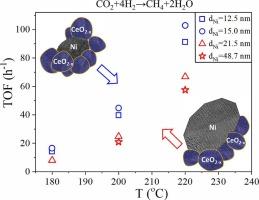CO2 methanation over Ni/Ce0.75Zr0.25O2 catalysts: Dependence on Ni particle size
IF 4.3
2区 工程技术
Q2 ENGINEERING, CHEMICAL
引用次数: 0
Abstract
A series of supported catalysts Ni/Ce0.75Zr0.25O2 with an equal Ni loading (9 wt%) was prepared via different routes. To obtain catalysts with higher metal dispersion, two methods were used: incipient wetness impregnation (IWI) of the support with an aqueous Ni(NO3)2 solution containing ethylene glycol (EG) and deposition–precipitation (DP) technique. Two catalysts were synthesized by conventional IWI using different Ni precursors (Ni(NO3)2 and [Ni(NH3)6](NO3)2). Diagnostics showed that the obtained catalysts differed in the dispersion of supported nanoparticles. Catalytic studies revealed the impact of Ni particle size in the range of 12–48 nm on the performance in the CO2 methanation. The enlargement of Ni particles resulted in a decrease in selectivity and CO2 methanation activity in terms of TOF. In situ synchrotron XRD and pseudo in situ XPS studies were used to detect alterations in the composition and structure of the catalysts that proceed during their activation by heating in a hydrogen-enriched atmosphere. The results showed that the activation treatment induces a partial reduction of the support material Ce0.75Zr0.25O2 due to Ni-mediated hydrogen spillover. In situ DRIFTS results pointed out that the generation of surface Ce3+ and oxygen vacancies during the support reduction opens an associative formate pathway in the CO2 methanation, which is widely believed to occur at the metal/support interfaces. The enhanced activity of the catalysts containing smaller Ni particles with developed contacts between the metal and support particles is most likely due to greater formate pathway contribution.

Ni/Ce0.75Zr0.25O2催化剂上的CO2甲烷化:对Ni粒度的依赖
通过不同途径制备了Ni/Ce0.75Zr0.25O2等Ni负载(9 wt%)负载催化剂。为了获得具有较高金属分散性的催化剂,采用了两种方法:含乙二醇(EG)的Ni(NO3)2水溶液对载体进行初湿浸渍(IWI)和沉积-沉淀(DP)技术。采用Ni(NO3)2和[Ni(NH3)6](NO3)2两种不同的Ni前驱体,采用常规IWI合成了两种催化剂。诊断结果表明,所获得的催化剂在负载纳米颗粒的分散上存在差异。催化研究表明,12 ~ 48 nm范围内的Ni粒径对CO2甲烷化性能有影响。镍颗粒的增大导致TOF的选择性和CO2甲烷化活性降低。采用原位同步加速器XRD和伪原位XPS研究来检测催化剂在富氢气氛中加热活化过程中组成和结构的变化。结果表明,活化处理导致载体材料Ce0.75Zr0.25O2因ni介导的氢溢出而部分还原。In situ DRIFTS结果指出,在载体还原过程中产生的表面Ce3+和氧空位开辟了CO2甲烷化的结合甲酸途径,人们普遍认为这一过程发生在金属/载体界面。含有较小镍颗粒的催化剂的活性增强,金属与载体颗粒之间的接触发展,很可能是由于更大的甲酸途径贡献。
本文章由计算机程序翻译,如有差异,请以英文原文为准。
求助全文
约1分钟内获得全文
求助全文
来源期刊

Chemical Engineering Science
工程技术-工程:化工
CiteScore
7.50
自引率
8.50%
发文量
1025
审稿时长
50 days
期刊介绍:
Chemical engineering enables the transformation of natural resources and energy into useful products for society. It draws on and applies natural sciences, mathematics and economics, and has developed fundamental engineering science that underpins the discipline.
Chemical Engineering Science (CES) has been publishing papers on the fundamentals of chemical engineering since 1951. CES is the platform where the most significant advances in the discipline have ever since been published. Chemical Engineering Science has accompanied and sustained chemical engineering through its development into the vibrant and broad scientific discipline it is today.
 求助内容:
求助内容: 应助结果提醒方式:
应助结果提醒方式:


